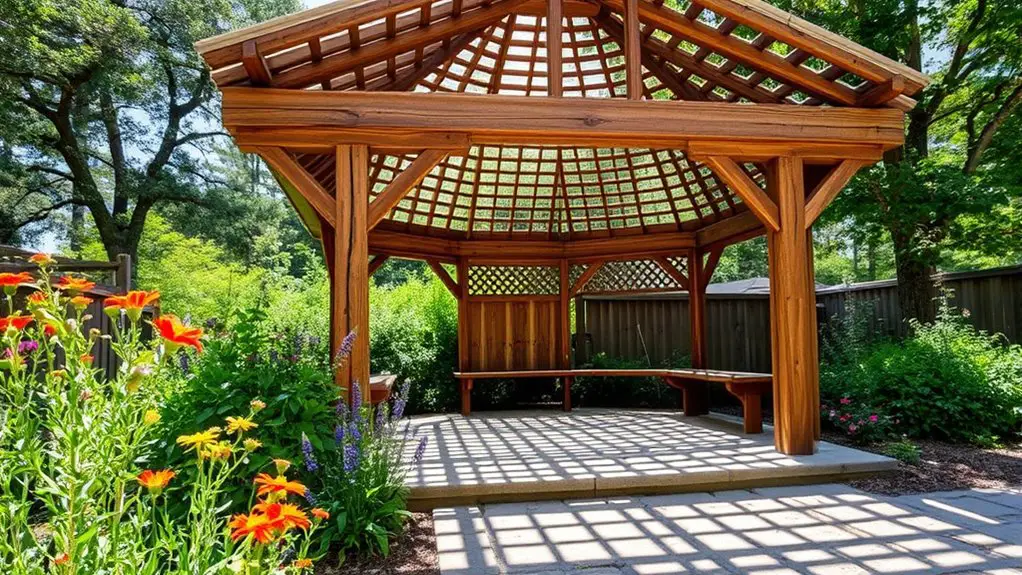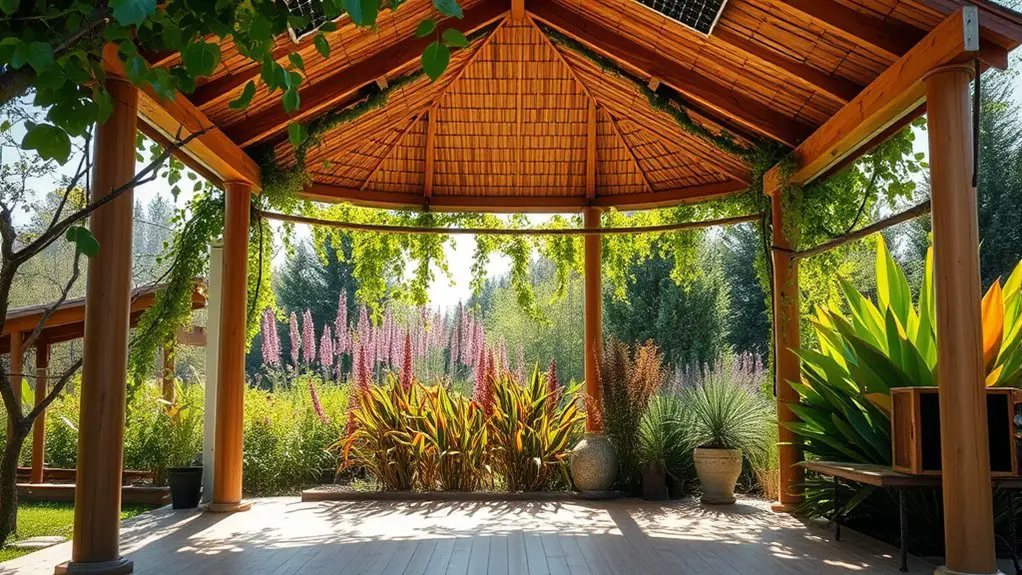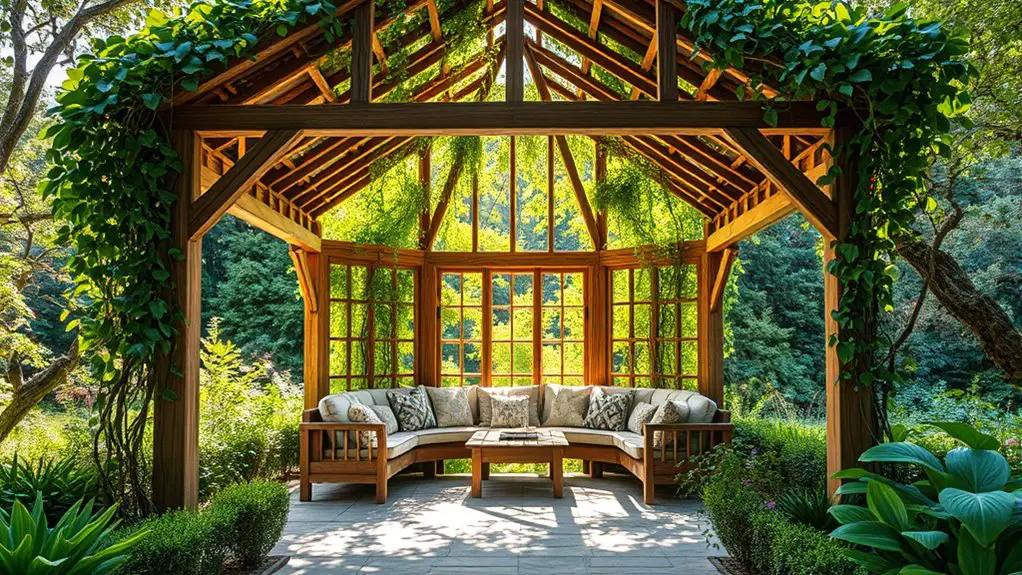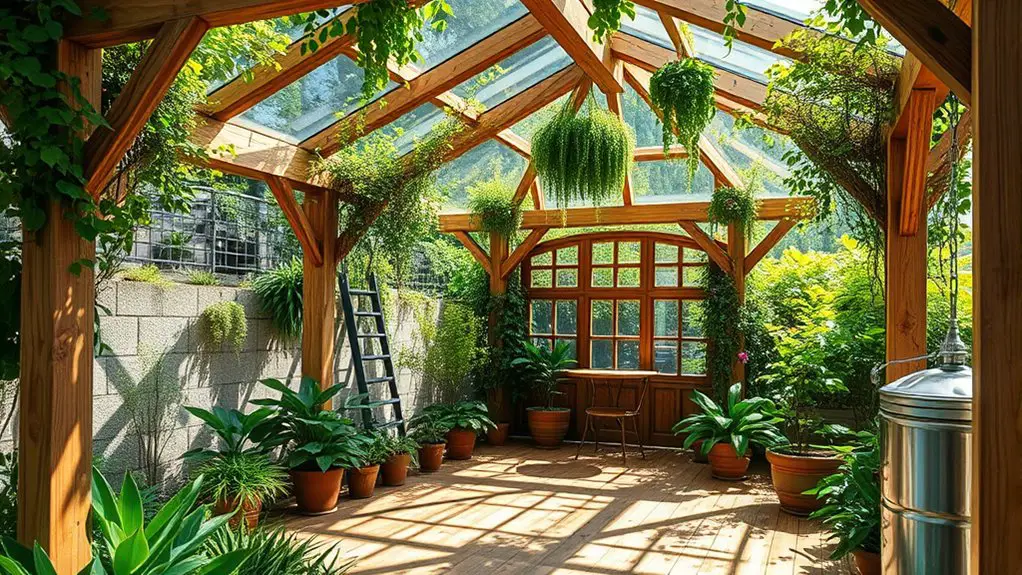For a zero-waste gazebo, consider using reclaimed materials like wood and metal to bring unique character and reduce waste. Embrace natural, locally sourced resources to lower your carbon footprint and support your community. Upcycle vintage furniture and decor to add charm while being eco-friendly. Incorporate a living roof for insulation and biodiversity, and choose non-toxic finishes to keep your space healthy. Want to discover more innovative ideas for your sustainable design?
Selecting Reclaimed Materials for Your Gazebo

When you’re designing a gazebo, selecting reclaimed materials not only enhances its charm but also reduces your environmental footprint. Using reclaimed wood for your structure adds character, with each piece telling a unique story. Imagine the warmth of weathered timber, which creates a cozy atmosphere for gatherings with friends and family.
Pair that with salvaged metal accents, like a vintage roof or decorative railings, to infuse an industrial flair. These materials not only look stunning but also save them from landfills, allowing you to embrace sustainability in style. Investing in naturally resistant wood options can further enhance the durability and longevity of your gazebo.
You’ll love the freedom that comes with customizing your gazebo; every reclaimed piece can be a reflection of your personality. Plus, sourcing locally means you’re supporting your community while minimizing transportation emissions. So go ahead, plunge into the world of reclaimed materials, and create a beautiful, eco-friendly gazebo that feels like an extension of your home.
Designing With Natural and Local Resources
When you’re designing your gazebo, consider using sustainable materials sourced from your local area. Not only does this reduce your carbon footprint, but it also supports regional economies and fosters a deeper connection to your environment. By adopting eco-friendly construction techniques, you can create a beautiful space that harmonizes with nature.
Sustainable Material Selection
Choosing sustainable materials is essential for creating a zero-waste gazebo that harmonizes with nature. By selecting biodegradable materials and innovative composites, you not only enhance your design but also contribute positively to the environment. Here are some materials to take into account:
- Bamboo: Fast-growing and incredibly strong, it’s a renewable resource.
- Reclaimed wood: Adds character while minimizing waste.
- Recycled metal: Durable and often available locally, it reduces the need for new mining.
- Natural fibers: Use for roofing or decor, they’re biodegradable and sustainable.
When you embrace these materials, you’re not just building a gazebo; you’re crafting a space that reflects your commitment to eco-friendliness and freedom from waste, all while enjoying the beauty of nature.
Regional Sourcing Benefits
Sourcing materials regionally for your zero-waste gazebo can considerably reduce your carbon footprint and support local economies. By working with local artisans, you’re not just getting unique, handcrafted pieces; you’re also fostering a sense of community and craftsmanship. Imagine the satisfaction of knowing your gazebo reflects the culture and resources of your area.
Using sustainable transport for these materials cuts down on emissions while ensuring they arrive in excellent condition. Plus, you get the chance to connect with the very people who create the resources you’re using. Embrace this innovative approach, and you’ll discover that designing with natural and local resources not only enhances your gazebo but also aligns with your eco-friendly values, giving you the freedom to create sustainably.
Eco-Friendly Construction Techniques
Building your zero-waste gazebo with eco-friendly construction techniques means embracing natural and local resources to create a sustainable structure. By choosing eco-conscious materials, you not only reduce your carbon footprint but also enhance the beauty of your gazebo with locally sourced elements. Here are a few ideas to weigh:
- Reclaimed wood from local suppliers
- Bamboo for its rapid growth and strength
- Natural stone for a rustic touch
- Eco-friendly finishes and paints
Incorporating these sustainable practices allows you to craft a space that aligns with your values and celebrates the environment. By prioritizing materials that harmonize with nature, you can design a gazebo that not only serves as a retreat but also reflects your commitment to a freer, greener lifestyle.
Incorporating Upcycled Furniture and Decor
While you’re creating your zero-waste gazebo, incorporating upcycled furniture and decor can not only enhance its aesthetic but also promote sustainability. Imagine transforming old wooden pallets into stylish upcycled seating that invites relaxation. You can even paint them in vibrant hues to match your vision. Vintage decor pieces, like an antique lantern or a retro table, add character and charm, creating a cozy atmosphere that feels uniquely yours.
Don’t shy away from mixing textures and styles; the beauty of upcycling lies in its unpredictability. Scour thrift stores or flea markets for unique finds, and let your creativity flow. Consider using reclaimed wood for shelves or decorative accents, tying everything together in an eco-friendly way. By choosing upcycled furniture and decor, you’re not just decorating; you’re making a statement about conscious living and freedom from waste. Embrace the journey of creating a gazebo that’s as individual as you are! Additionally, using sustainable and eco-friendly materials can further enhance the environmental benefits of your gazebo design.
Utilizing Sustainable Roofing Options

When it comes to your gazebo, choosing sustainable roofing options can make a huge difference. Imagine a vibrant green roof that not only provides insulation but also supports local biodiversity. You can also explore recycled materials and even integrate solar panels, turning your gazebo into an eco-friendly haven.
Green Roof Benefits
If you’re looking to enhance your gazebo’s sustainability, incorporating a green roof can be a game-changer. Not only does it create a vibrant space, but it also supports green roof ecosystems and boosts urban biodiversity. Here are some benefits to reflect upon:
- Natural Insulation: A green roof helps regulate temperatures, reducing energy costs.
- Stormwater Management: It absorbs rainwater, minimizing runoff and preventing flooding.
- Wildlife Habitat: Attracts pollinators and local wildlife, enriching your environment.
- Air Quality Improvement: Plants filter pollutants, contributing to cleaner air.
Recycled Material Options
As you explore sustainable roofing options for your gazebo, consider the benefits of using recycled materials. Utilizing recycled plastics not only reduces waste but also provides a durable, weather-resistant solution that can mimic traditional materials. Imagine a vibrant, colorful roof that’s both eco-friendly and eye-catching! Reclaimed wood is another fantastic option, adding a rustic charm while telling a story of its previous life. This wood is often stronger and more character-rich than new lumber, giving your gazebo a unique touch. By choosing these materials, you’re not just creating a beautiful space; you’re also making a commitment to sustainability. Embrace your freedom to innovate while caring for the planet—your gazebo can be a reflection of your values and style.
Solar Panel Integration
How can you enhance your gazebo’s sustainability while harnessing the power of the sun? Integrating solar panels into your gazebo’s design not only boosts its solar efficiency but also paves the way for energy independence. By utilizing sustainable roofing options, you create a space that’s both functional and eco-friendly.
- Choose lightweight, durable solar panels that blend seamlessly with your gazebo.
- Opt for a green roof to enhance insulation and support biodiversity.
- Use recycled materials for the roofing framework to minimize waste.
- Position your panels for maximum sun exposure throughout the day.
With these ideas, you’ll embrace a lifestyle of freedom while making a positive impact on the environment. Your gazebo can be a sanctuary of sustainability and innovation!
Embracing Biophilic Design Principles

While integrating biophilic design principles into your zero-waste gazebo can seem intimidating, it’s actually a rewarding way to connect with nature and enhance your outdoor space. Start by using natural materials, like reclaimed wood or bamboo, to create a warm, inviting atmosphere. Consider incorporating large windows or open walls that allow sunlight to flood in, blurring the lines between indoor and outdoor living.
You might also add plants, such as climbing vines or hanging greenery, to bring life and color to your gazebo. This not only fosters a deeper nature connection but improves air quality, too. Additionally, a personalized gazebo can complement the overall outdoor area, increasing comfort and enjoyment. Choose furniture made from sustainable resources that complements the natural surroundings, allowing you to relax and rejuvenate freely. With biophilic design, you’re not just creating a space; you’re cultivating a sanctuary that celebrates the beauty of nature and encourages a harmonious lifestyle.
Implementing Rainwater Harvesting Systems
Rainwater harvesting systems can transform your gazebo into a sustainable oasis, providing a free water source for plants and reducing your environmental footprint. You’ll discover practical installation techniques and maintenance tips to keep your system efficient and effective. Let’s explore how this eco-friendly approach can enhance your outdoor space while promoting a zero-waste lifestyle.
Benefits of Rainwater Harvesting
When you consider the impact of water conservation, implementing rainwater harvesting systems can be a game-changer for sustainable living. By capturing and reusing rainwater, you not only reduce your reliance on municipal sources but also contribute to effective stormwater management. Here are some benefits to keep in mind:
- Cost savings: Lower your water bills by utilizing free rainwater.
- Environmental impact: Decrease runoff and erosion, promoting healthier ecosystems.
- Self-sufficiency: Gain independence from water supply fluctuations.
- Quality control: With proper rainwater filtration systems, you can guarantee cleaner water for various uses.
Embracing rainwater harvesting isn’t just practical; it liberates you from conventional water constraints while enhancing your eco-friendly lifestyle.
Installation Techniques and Tips
To successfully implement a rainwater harvesting system, you’ll want to carefully consider both your location and the specific needs of your property. Start by choosing the right installation tools, like gutters and downspouts, that fit your gazebo’s design. Be prepared for installation challenges, such as ensuring proper slope for drainage and securely connecting your storage tank. It’s essential to map out your system before starting, so you won’t face surprises mid-installation. Consider integrating a first-flush diverter to keep your water clean. If you’re feeling adventurous, try using salvaged materials to minimize waste. With a little creativity and determination, you can create a sustainable water source that empowers you to embrace a greener lifestyle.
Maintenance and System Care
Although maintaining your rainwater harvesting system might seem intimidating, regular care can confirm its efficiency and longevity. Embracing a routine maintenance schedule not only enhances your system’s performance but also fosters a sustainable lifestyle. Here are a few essential tasks to keep in mind:
- Conduct routine inspections of the gutters and downspouts to prevent blockages.
- Clean the filtration system regularly to guarantee peak water quality.
- Check for leaks or cracks in storage tanks and repair them promptly.
- Monitor your water usage to identify potential issues or areas for improvement.
Choosing Eco-Friendly Finishes and Treatments
Choosing eco-friendly finishes and treatments can transform your gazebo into a sustainable sanctuary, as you not only enhance its aesthetic appeal but also protect the environment. Opt for eco-friendly paints that minimize harmful emissions and come in vibrant colors to express your style. Look for brands that prioritize sustainability and use natural ingredients, ensuring your outdoor haven remains toxin-free. When it comes to wood surfaces, consider natural stains that highlight the grain while providing protection from the elements. These stains are often derived from plant-based oils and pigments, making them a safe choice for you and your surroundings. You’ll love how easy they are to apply and maintain, giving your gazebo a fresh, inviting look without sacrificing your eco-conscious values. Additionally, selecting paints with weather resistance ensures your gazebo will withstand the elements while maintaining its beauty.
Creating Wildlife-Friendly Spaces
Creating a wildlife-friendly space in your gazebo not only enhances your outdoor experience but also fosters a thriving ecosystem. By integrating nature into your design, you can create inviting wildlife habitats that support local fauna and flora. Here are some innovative ideas to ponder:
Designing a wildlife-friendly gazebo enriches your outdoor space while promoting a vibrant ecosystem for local wildlife.
- Incorporate native plants in your pollinator gardens to attract bees, butterflies, and birds.
- Install birdhouses and feeders to provide shelter and food for local avian species.
- Use natural materials for seating and decor, ensuring they blend seamlessly with the surrounding environment.
- Create a water feature like a small pond or birdbath to encourage wildlife visits.
Planning for Long-lasting Durability
When you prioritize long-lasting durability in your gazebo design, you’re not just investing in a structure; you’re making a commitment to sustainability and resilience. By focusing on durability metrics, you can guarantee your gazebo withstands the test of time while minimizing waste. Choosing materials with a longer lifespan not only reduces replacement frequency but also lessens your ecological footprint. Additionally, considering the environmental impact of materials is essential for making informed decisions regarding sustainability.
Here’s a quick reference table to help you choose wisely:
| Material | Lifespan (Years) | Durability Metrics |
|---|---|---|
| Cedar Wood | 15-30 | Naturally rot-resistant |
| Steel | 25-50 | High tensile strength |
| Recycled Plastic | 30+ | UV and weather resistant |
Engaging the Community in Your Project
Engaging your community in the gazebo project can turn a simple structure into a vibrant gathering space. By inviting local voices, you not only foster connections but also enhance the design with diverse ideas. Here are some practical ways to involve everyone:
Engaging your community in the gazebo project transforms it into a lively gathering space filled with diverse ideas.
- Host community workshops: Encourage input on design, materials, and functions, ensuring everyone’s voice is heard.
- Utilize collaborative planning: Work together to create a blueprint that reflects your community’s unique character and needs.
- Incorporate local resources: Showcase sustainable materials and craftsmanship, supporting local businesses and reducing waste.
- Plan for ongoing engagement: Create opportunities for maintenance and events, keeping the space alive and relevant. Additionally, consider how your gazebo can serve as a venue for community events to further strengthen neighborhood ties and enhance its role in local culture.
Frequently Asked Questions
How Can I Make a Gazebo Without Producing Any Waste?
You can create a gazebo without waste by using sustainable materials and embracing a modular design. It’ll allow you to repurpose components easily, giving you freedom to adapt as you enjoy nature’s beauty around you.
What Are the Best Practices for Disposing of Construction Waste?
When disposing of construction waste, prioritize construction recycling and effective waste management. You can find local recycling facilities, repurpose materials creatively, and guarantee everything’s sorted. That way, you’re embracing eco-friendly practices while keeping your project sustainable.
Can I Use Non-Recyclable Materials in a Zero-Waste Gazebo?
You shouldn’t use non-recyclable materials in your design. Instead, consider sustainable materials and eco-friendly alternatives that promote a healthier environment. This choice not only supports your vision but also grants you creative freedom in construction.
How Do I Maintain a Zero-Waste Gazebo Over Time?
To maintain a zero-waste gazebo, focus on using sustainable materials and commit to regular maintenance. Regular checks and repairs guarantee longevity, allowing you to enjoy your space freely while minimizing environmental impact. It’s a win-win!
What Are Common Mistakes to Avoid in Zero-Waste Gazebo Design?
When designing, avoid common pitfalls like poor material selection and overlooking sustainability. You’ll want to prioritize eco-friendly options that minimize waste, ensuring your project reflects your desire for freedom and harmony with nature.

